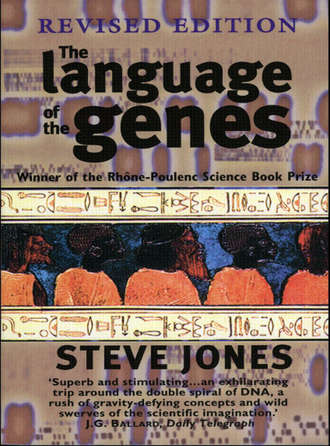
Полная версия
The Language of the Genes
The scenery for most of the trip is tedious. Like much of modern Britain it seems to be unproductive. About a third of the whole distance is covered by repeats of the same message. Fifty miles, more or less, is filled with words of five, six or more letters, repeated next to each other. Many are palindromes. They read the same backwards as forwards, like the obituary of Ferdinand de Lesseps – ‘A man, a plan, a canal: Panama!’ Some of these ‘tandem repeats’ are scattered in blocks all over the genome. The position and length of each block varies from person to person. The famous ‘genetic fingerprints’, the unique inherited signature used in forensic work, depend on variation in the number and position of such segments. Other repeated sequences involve just the two letters, C and A, multiplied thousands of times while yet more are remnants of ancient viruses. Large sections of the genome are given over to long and complicated messages that seem to say nothing.
It is dangerous to dismiss all this DNA as useless because we do not understand what it says. The Chinese term ‘Shi’ can – apparently – have seventy-three different meanings depending on how it is pronounced. It is possible to construct a sentence such as ‘The master is fond of licking lion spittle’ just by using ‘Shi’ again and again. This would seem like empty repetition to those who cannot speak Chinese.
Much of the inherited landscape is littered with the corpses of abandoned genes, sometimes the same one again and again. The DNA sequences of these ‘pseudogenes’ look rather like that of their functional relatives, but are riddled with decay and no longer make anything. At some time in their history a crucial part of the machinery was damaged. Since then they have been rusting. Oddly enough, the same pseudogenes may turn up at several points along the journey.
After many miles of dull and repetitive DNA terrain, we begin to see places where some product is made. These are the functional genes. They, too, have some surprises in their structure. Each can be recognised by the order of the letters in the DNA alphabet, which start to read in words of three letters written in the genetic code, as a hint that it could produce a protein. In most cases there are few clues about what its product does, although its structure can be deduced (and its shape inferred) from the order of its DNA letters.
Most genes are arranged in groups that make related products, with about a thousand of these ‘gene families’ altogether. One is involved in the manufacture of the red pigment of the blood. Most of the DNA in the bone-marrow cells which produce the red cells of the blood is switched off. One small group of genes is hard at work. As a result they are better known than any other. Much of human molecular biology grew from research on this particular genetic industrial centre, the globin genes.
They have two factories. One is halfway along the genetic road to John o’Groat’s – in Leeds. It makes one part of the protein involved in carrying oxygen. The beta-globin industrial estate contains about half a dozen sections of DNA that code for related things. That responsible for part of adult haemoglobin (and involved, when it goes wrong, in sickle-cell disease) is quite small: about three feet long on this map’s scale. A few feet away is another one which makes a globin found in the embryo. Close to that is the decayed hulk of some equipment which stopped working years ago. The beta-globin factory covers about a hundred feet altogether, most of which seems to he unused space between functional genes. It co-operates with a sister estate, the alpha-globin unit, a long way away, (near London, on this mythical map) which produces a related protein. When joined together, the two products make the red blood pigment itself. Most genes are arranged in families, either close together or scattered all over the genome.
The map of ourselves shows that genes are of very different size, from about five hundred letters long to more than two million. One makes the largest known protein, titin, a molecular shock-absorber; a long, pleated structure found in muscles, in blood cells and in chromosomes. Whatever the size of its product, titin is by no means the largest gene. Most human genes have their functional segments interrupted by lengths of non-coding DNA – in Huntington’s disease, for example, by nearly seventy In many genes (such as the one which goes wrong in muscular dystrophy) the great majority of the DNA codes for nothing. The non-coding material, whose importance varies greatly from gene to gene, participates in the first part of the production process, but this segment of the genetic alphabet is snipped out of the message before the protein is assembled. This seems an odd way to go about things, but it is the one which evolution has come up with.
The general picture began to emerge as soon as the mappers began work. In the year 2000 – almost exactly a century after the rediscovery of Mendel’s rules – their labours were, in effect, complete and the whole human gene sequence was laid out in all its tedium before a less than startled world. Three thousand million letters (or, as now it appears, slightly more) is a lot. For accuracy, each section had to be sequenced ten times or more and even at a thousand DNA bases a second (which is what the machinery pumps out) that was not easy. Sixteen centres, in France, Japan, Germany, China, Britain and the United States combined to do the job. Most were funded by governments or charities, with the notorious exception of the Celera Genomics company (their motto: ‘Discovery Can’t Wait!’), whose head defected from a government programme. Advances in technology reduced the original estimate of three billion dollars by ten times which, for a project – described by President Clinton as the most wondrous map ever produced – with far more scientific weight than the Moon landings, was a remarkable bargain. For much of the time, the private and public sectors were at daggers drawn (vividly illustrated by Celera’s description of the director of one public laboratory behaving as if he had been bitten by a rabid dog).
Конец ознакомительного фрагмента.
Текст предоставлен ООО «ЛитРес».
Прочитайте эту книгу целиком, купив полную легальную версию на ЛитРес.
Безопасно оплатить книгу можно банковской картой Visa, MasterCard, Maestro, со счета мобильного телефона, с платежного терминала, в салоне МТС или Связной, через PayPal, WebMoney, Яндекс.Деньги, QIWI Кошелек, бонусными картами или другим удобным Вам способом.





